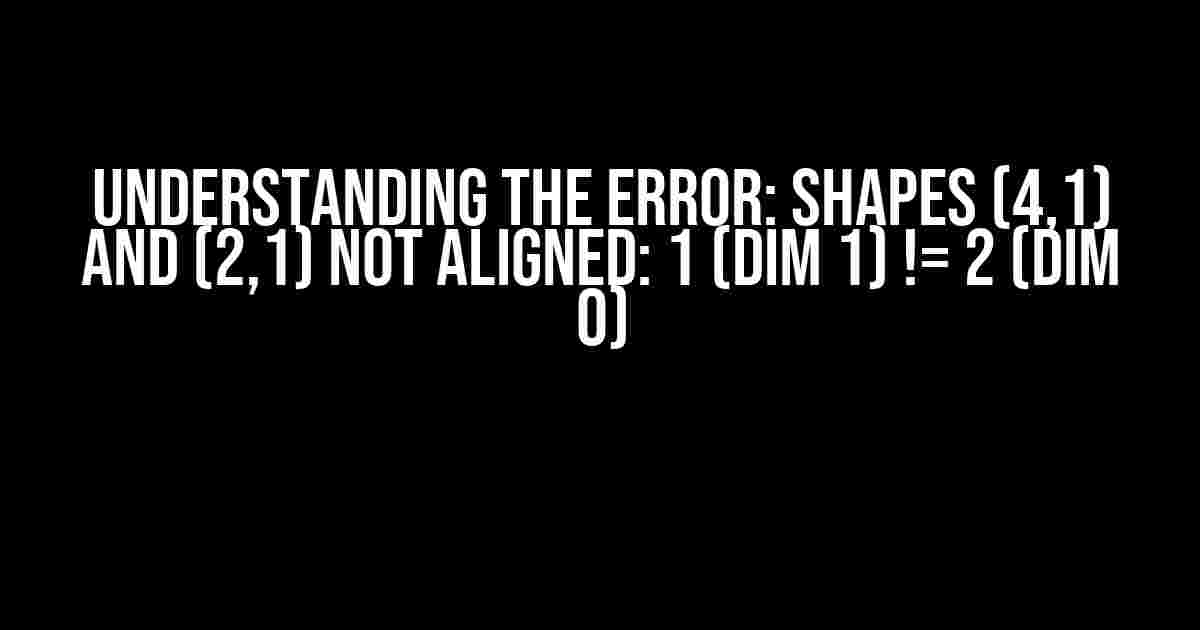In the world of machine learning and data science, encountering errors is a common phenomenon. One such error that can stump even the most experienced professionals is the “Shapes (4,1) and (2,1) not aligned: 1 (dim 1) != 2 (dim 0)” error. In this article, we will delve deeper into the causes of this error and provide solutions to overcome it.
What does the error mean?
This error typically occurs when there is a mismatch between the shapes of two arrays or matrices that need to be aligned for a specific operation. The error message specifically highlights the issue, stating that the shapes (4,1) and (2,1) are not aligned, and the dimensions 1 and 0 are not equal.
Causes of the error
The error can occur due to various reasons, including:
- Incorrect data preprocessing
- Inconsistent data shapes
- Incorrect model architecture
- Incorrect data types
Solutions to the error
To resolve the “Shapes (4,1) and (2,1) not aligned: 1 (dim 1) != 2 (dim 0)” error, follow these steps:
- Check the shape of your data using the
shapeattribute. - Verify that the data types of the arrays or matrices are consistent.
- Reshape the data to ensure that the dimensions are aligned.
- Review your model architecture to ensure that it is compatible with the data shape.
Best practices to avoid the error
To avoid encountering the “Shapes (4,1) and (2,1) not aligned: 1 (dim 1) != 2 (dim 0)” error in the future, follow these best practices:
- Consistently check the shape of your data during preprocessing.
- Verify data types before performing operations.
- Use consistent model architectures.
By understanding the causes of the “Shapes (4,1) and (2,1) not aligned: 1 (dim 1) != 2 (dim 0)” error and implementing the solutions and best practices outlined above, you can overcome this error and ensure smooth execution of your machine learning and data science projects.
Frequently Asked Question
Get the scoop on why your shapes are not aligning and how to fix it!
What does the error message “Shapes (4,1) and (2,1) not aligned: 1 (dim 1) != 2 (dim 0)” mean?
This error message indicates that the shapes of two arrays or tensors are incompatible for a specific operation. In this case, the shapes are (4,1) and (2,1), which means the first array has 4 rows and 1 column, while the second array has 2 rows and 1 column. The issue is that the dimensions don’t match, specifically, the first dimension (dim 0) has different sizes (4 and 2).
What causes this shape mismatch error?
This error can occur due to various reasons, such as incorrect data preparation, wrong array indexing, or mismatched tensor dimensions. It can also happen when trying to perform operations on arrays or tensors with incompatible shapes, like matrix multiplication or concatenation.
How can I fix the shape mismatch error?
To fix this error, you need to ensure that the shapes of the arrays or tensors are compatible for the operation you’re trying to perform. This might involve resizing or reshaping the arrays, transposing them, or adjusting the indexing to match the shape requirements. You can use various techniques like numpy’s `reshape()` or `transpose()` functions to adjust the shapes.
Is it possible to ignore the shape mismatch error?
While it’s technically possible to ignore or suppress the shape mismatch error, it’s not recommended as it can lead to unexpected results, errors, or even crashes. It’s essential to address the shape mismatch issue to ensure the correctness and reliability of your code.
What tools can help me debug shape mismatch errors?
Several tools can help you debug shape mismatch errors, including popular libraries like NumPy, Pandas, and Matplotlib. Additionally, Python’s built-in `print()` function and debuggers like PDB can be useful in inspecting the shapes and dimensions of your arrays and tensors.



